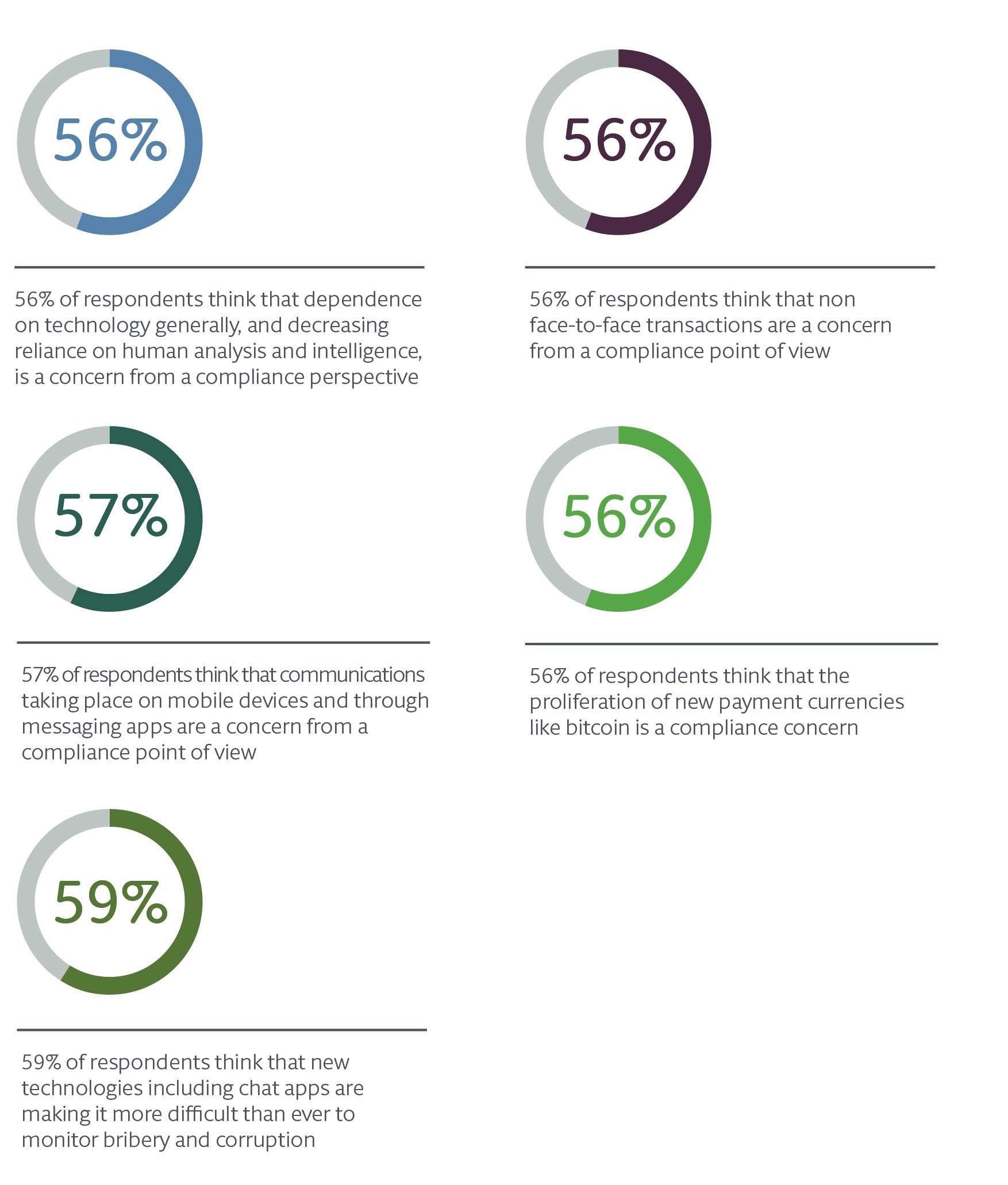Technology is a double-edged sword for compliance leaders
As technology provides a proliferation of new ways to work, communicate, and pay for goods and services, it brings both challenges and opportunities for AB&C compliance. Over half of compliance leaders express anxiety about dependence on technology and the rise of non-face-to-face transactions from a compliance perspective, but technology like blockchain and AI can also help tackle corruption and increase transparency.
Figure 4: Compliance leaders are concerned that a proliferation of new payment methods and a reliance on mobile messaging apps pose additional compliance challenges

The tech time bomb?
The potential for encrypted messaging and payment services to enable corrupt behavior is keeping compliance leaders awake at night. Almost 60% of respondents agree that technologies like chat apps on smartphones are making it harder than ever to monitor bribery and corruption, and a similar proportion (57%) agree that messaging app communications pose compliance concerns. These anxieties are likely to grow as usage increases. Mobile messaging platform WhatsApp – which features end-to-end encryption to keep messages private – currently has around 1.5 billion users, with a market penetration rate of over 80% in some countries.2 The Chinese messaging app WeChat has over 1 billion monthly active users, and is used by over 80% of Chinese smartphone users.3 In China, levels of concern are particularly high: more than two-thirds (68%) of Chinese compliance leaders have concerns about communications taking place over messaging apps.
Cryptocurrencies like bitcoin also bring fresh compliance challenges. These payment methods offer both transparency and a certain level of anonymity: every transaction is permanently recorded and traceable, but most platforms are ‘pseudonymous’, meaning that users are not easily identifiable. It’s perhaps not surprising, therefore, that 56% of the compliance leaders in our study believe that new payment methods are a compliance concern. Governments and regulators are only just beginning to put frameworks in place to control the use of cryptocurrencies, and corporates are realizing that they need to work quickly to understand fully the implications of these technologies and draw up policies and guidance to govern their use.
Digital communication methods can be both a blessing and a curse in terms of AB&C compliance. Those keen to commit offences may believe that encrypted digital communications can go undetected, but capturing traffic from these channels is usually relatively easy. However, they do raise potential data privacy issues. Personal phones are often used for work communications and vice versa, meaning that employees are reluctant to hand over phones for investigations.
Trying to stop the use of technology is like trying to stop a river. While some companies tell employees that they should only communicate with each other and suppliers on company-authorized channels, it’s inevitable that people will use other methods, such as WhatsApp, Facebook Messenger, and WeChat.
Companies therefore need to put in place clear policies and training programs governing the use of technology, and build a company culture that emphasizes values and is role-modeled by leaders.
Peter Spivack
Partner, Washington D.C.
Technology as a compliance tool
It is understandable that compliance leaders have concerns around the dark spaces that new technology can create where illegal activity can take place undetected. However, tech tools can also help in the battle against bribery and corruption, enabling more comprehensive compliance monitoring and encouraging greater transparency. Some companies have created internal applications for actions like transport bookings and meal purchasing, for example, helping them to monitor employee spending and quickly detect anomalies and possible issues. On the investigation side, data analysis and document review tools are being used to make significant efficiency improvements.
In terms of future tools, blockchain could prove to be particularly powerful. Although over half of compliance leaders believe that new payment currencies like bitcoin are a compliance concern, the blockchain technology that underpins cryptocurrencies can actually help to make corruption more difficult. The ‘open ledger’ database records every transaction, embedding contracts in code that are protected from revision or deletion. This ledger is stored in blocks across a chain of distributed computers, so that there’s no single point of failure. This can ensure data integrity and transparency, creating a visible trail of transactions that cannot be changed or falsified. Blockchain technology can therefore help with guaranteeing identity, registering corporate assets, procuring contracts, and tracking funds. Pilots are underway around the world to experiment with how blockchain can track transactions – especially high-risk government transactions such as public contracts, cash transfers, and aid money – to lower the incidence of fraud.
In Colombia, for example, where corruption is thought to cost the country around $17 billion a year,4 a project is underway to use blockchain technology for the selection of school food vendors.5 Historically, government contracts have been rife with corruption, due in part to the complex and opaque tender process and the involvement of multiple stakeholders. The blockchain solution would create an immutable record of bids, preventing companies from altering tenders after submitting them. Given that our survey respondents ranked Colombia as the second most concerning country in Latin America from an AB&C perspective, harnessing tools like blockchain to overcome corruption issues could pay real dividends.
But blockchain isn’t the only technology that could change the face of AB&C. Artificial intelligence (AI) and “big data” analytics are also capable of revolutionizing the way that we detect corruption and foster greater transparency. In an effort to transform the public sector, the World Bank is looking at how AI can sift through huge volumes of data on World Bank-financed procurement, rapidly identifying patterns and flagging signs of corruption.6
This tide of new technology is approaching swiftly, and used effectively it could transform the enforcement of AB&C legislation.
2 https://www.businessofapps.com/data/whatsapp-statistics/
3 https://www.businessinsider.com/wechat-has-hit-1-billion-monthly-active-users-2018-3?r=US&IR=T
4 https://www.reuters.com/article/us-colombia-election-corruption/colombias-rampant-corruption-a-hot-topic-in-presidential-vote-idUSKBN1JB252
5 https://www.weforum.org/agenda/2019/05/heres-how-blockchain-stopped-corrupt-officials-stealing-school-dinners/
6 https://blogs.worldbank.org/governance/can-artificial-intelligence-stop-corruption-its-tracks